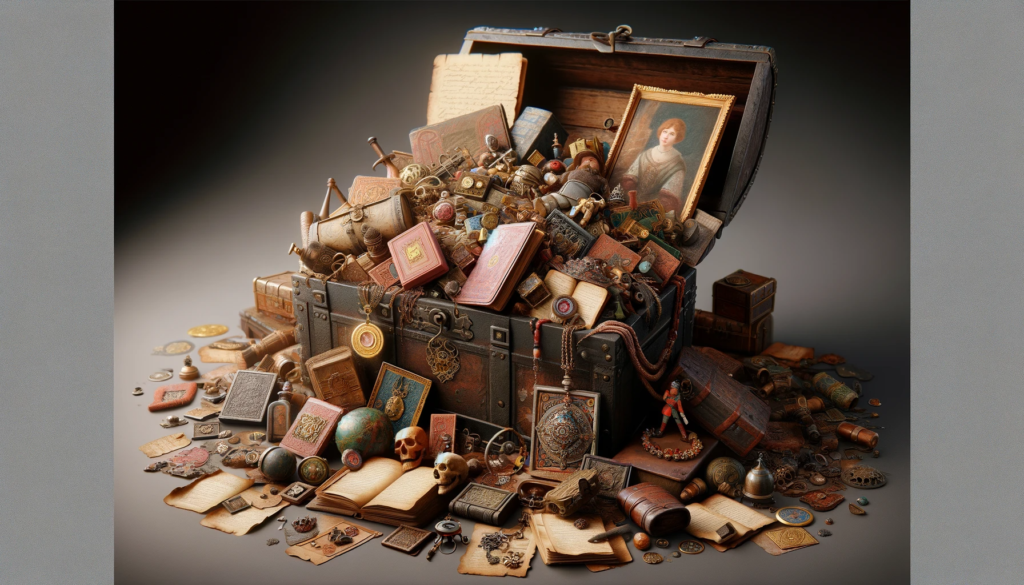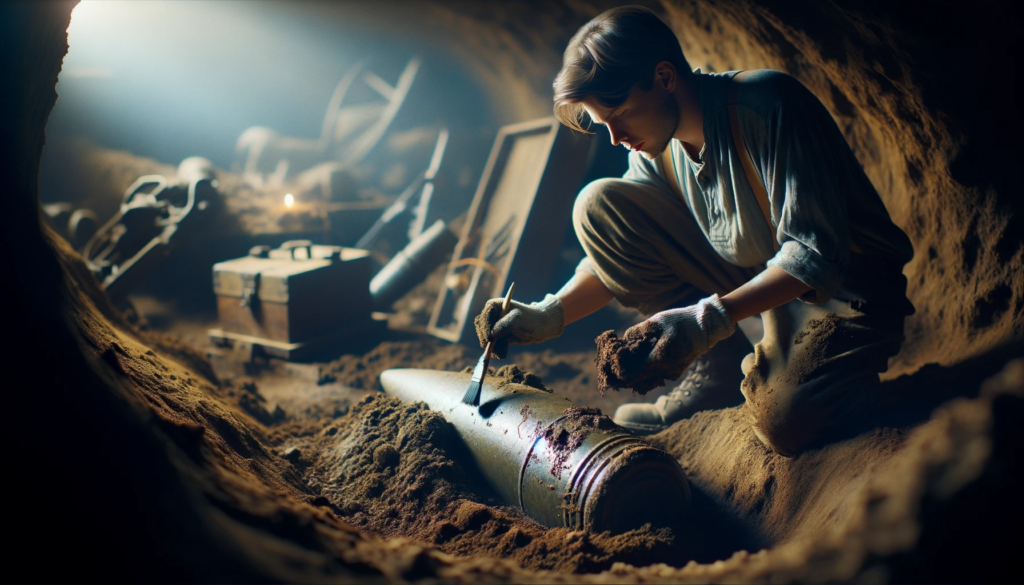The American Revolutionary War was a pivotal moment in history that shaped the future of a nation and the world. The artifacts from this era offer a fascinating glimpse into the past, providing insights into the lives, struggles, and victories of those who fought for American independence.
In this comprehensive guide, we’ll explore the captivating world of Revolutionary War artifacts. You’ll uncover what types of artifacts exist, their history and significance, how they are discovered and preserved, their presence in modern culture, and key legal and ethical considerations around these precious pieces of history.
Key Takeaways

- Revolutionary War artifacts encompass a variety of objects from weapons to clothing to personal items that provide insights into both warfare and daily life during the era.
- Iconic artifacts like the Liberty Bell and George Washington’s uniform hold special historical significance. Prisoner of war journals reveal the war’s brutality.
- Archaeologists and historians play crucial roles in scientifically discovering and interpreting artifacts found at unexpected sites.
- Museums and collectors preserve and display artifacts using meticulous techniques to prevent deterioration over time.
- Revolutionary War artifacts maintain a strong presence in modern culture, inspiring education programs, exhibitions, literature, and media around the nation.
- Laws aim to enforce ethical handling, ownership, and access to artifacts by balancing preservation, education, research, and commemoration.
Types of Artifacts

There are several major categories of Revolutionary War artifacts that provide different perspectives into life during that era:
Weapons
- Muskets
- Cannons
- Swords
- Ammunition
Military weapons like muskets with bayonets, cannons, swords, and crude ammunition speak to the intensity and violence of the Revolutionary War. Preserved in remarkable condition centuries later, these artifacts provide a stark reminder of the conflict’s gritty reality.
Studying Revolutionary War weapons offers insights into 18th-century weaponry technology, battle strategy, and how weapons were used in clashes between the Continental Army and British forces.
Uniforms and Clothing
- Military uniforms
- Clothing
- Hats
- Boots
Uniforms, clothing, hats, and lace-up leather boots worn by soldiers and civilians reflect Revolutionary War-era fashion and provide glimpses into daily life.
Different uniform items signified allegiance, military rank and role, and social status. Clothing was hand-stitched from materials like wool, linen, silk, and leather. Uniform buttons and insignia have their own historical significance.
Personal Items
- Letters
- Diaries
- Journals
- Writing kits
- Eyewear
Letters exchanged between soldiers and loved ones back home, along with diaries, journals, writing kits, and early eyewear spectacles capture the personal and human aspect of the Revolutionary War.
These artifacts provide insights into the writers’ identities, relationships, motivations for enlisting, military activities, political views, daily routines, and emotional landscape. They put individual faces onto the big events.
Art and Decorations
- Flags
- Paintings
- Sculptures
- Badges
- Jewelry
Flags, paintings, sculptures, badges with patriotic symbols, and jewelry represent the creative expression and cultural feel of Revolutionary War-era America.
The imagery and symbolism convey the patriotic sentiments and artistic trends that defined this pivotal point in American history. They highlight national pride and enthusiasm for independence.
Notable Artifacts and Their Significance
While Revolutionary War artifacts encompass a wide range, several standouts hold special historical meaning:
The Liberty Bell

The Liberty Bell is an iconic symbol of American independence. Housed in Philadelphia, this bell rang out announcements of the first public readings of the Declaration of Independence.
The bell’s famous crack happened sometime in the 19th century. Some believe the crack represents the divisions that nearly tore the young nation apart during formation. Despite the damage, we still view the Liberty Bell as a resilient symbol of freedom.
George Washington’s Uniform and Camp Equipment
As commander-in-chief of the Continental Army and America’s first president, George Washington led the nation to independence.
Washington’s uniform, camp bed, marquee tent, and personal artifacts provide insights into Washington’s experiences and leadership during the war’s significant moments.
Journals of Prisoners of War
Revolutionary War prisoner of war journals relay harrowing tales of capture, harsh conditions aboard British prison ships, diabolical treatment, and cramped confinement.
These rare first-hand accounts expose the war’s severe brutality and reveal remarkable stories of resourcefulness and resilience.
Discovery and Preservation

Revolutionary War artifacts often emerge from the most unexpected places centuries later —unearthed on battlefields, uncovered during construction projects, found tucked away in attics of old houses.
Discovering these artifacts connects us directly with forgotten history and lost stories. Professional archaeologists and historians play several important roles:
- Locating and carefully unearthing artifacts
- Accurately interpreting significance and context
- Using technologies like LIDAR scanning and GIS mapping to analyze landscapes and patterns
- Studying artifacts to reveal new insights about pivotal events and practices during the war era
Once discovered, proper preservation of these fragile artifacts presents an ongoing challenge. Deteriorating factors like:
- Air pollution
- Humidity
- Sunlight
- Fluctuating temperatures
can rapidly accelerate decay of metal, leather, paper, wood, and fabrics. Preventative care and conservation are vital.
Techniques used by museums and collectors include:
- Storing items in specialized archival cardboard boxes and acid-free tissue paper
- Displaying artifacts in regulated, climate-controlled cases
- Establishing light exposure limits
- Using insect traps and ventilation systems
- Practicing meticulous object handling and cleaning methods
These preservation efforts pass Revolutionary War artifacts on to future generations in the best possible condition so the stories endure.
Revolutionary War Artifacts in Modern Culture

Revolutionary War artifacts maintain strong prominence in modern American society through:
Museums and Exhibitions
Sprawling museums like the Smithsonian Museum of American History in Washington, D.C. and the Museum of the American Revolution in Philadelphia house thousands of Revolutionary War artifacts in their collections and feature them prominently in exhibitions.
Educational Programs
Replicas of popular artifacts help students experience history hands-on without risking damage to fragile originals. Reenactment events at schools and historic sites use props to depict Revolutionary War life.
Media and Literature
Revolutionary war artifacts inspire books like Laurie Halse Anderson’s Chains, films like The Patriot, and the hit Broadway musical Hamilton. They inject vivid visual detail that transports audiences back in time.
Key Legal and Ethical Considerations

The legal and ethical handling of Revolutionary War artifacts involves several key considerations:
- Laws like the Archaeological Resources Protection Act require permits for excavating sites on public lands and regulate artifact sale and transport. These laws aim to prevent looting and illegal trading.
- Debate continues around publicly displaying artifacts versus preserving them unseen in private collections. There are arguments on both sides regarding access and integrity.
- Removing artifacts from battlefields or gravesites sparks discussions around treating these locations with dignity as historic memorials or even consecrated ground.
In summary, the debates boil down to balancing preservation, education, commemoration, and permission. Ongoing discussions explore how to handle artifacts respectfully while making America’s formative history accessible to all.
Frequently Asked Questions

What are some examples of Revolutionary War weapons?
Some common weapons used during the Revolutionary War include muskets with bayonets, pistols, cannons, mortars, rifles, swords, pikes, tomahawks, and artillery shells. Both the British and American sides used similar weaponry.
Where are some of the best places to see Revolutionary War artifacts?
Some top museums to view extensive Revolutionary War artifact collections include the Smithsonian Museum of American History, the Museum of the American Revolution in Philadelphia, the Metropolitan Museum of Art in New York City, and battle site parks like Saratoga and Yorktown.
How were Revolutionary War artifacts originally preserved?
In the 18th century, paper documents were folded up and stored in desks and trunks, while weapons and uniforms remained in use or passed through families as heirlooms. Specific preservation methods developed more recently to actively combat deterioration.
What conservation steps help preserve Revolutionary War artifacts today?
Common modern preservation techniques include regulating light, humidity, air quality, and temperature during display and storage to slow decay. Other best practices are using archival-quality boxes, prohibiting flash photography, handling objects with gloves, and performing occasional restoration.
Have significant Revolutionary War artifacts ever gone missing or been stolen?
Yes, unfortunately various important Revolutionary War items have disappeared or fallen prey to thieves over the last two centuries. For example, in the 1990s over 200 historic weapons vanished from Valley Forge State Park and have never been recovered.
How has analysis of Revolutionary War artifacts evolved over time?
Historical analysis techniques have grown much more scientific over the decades. 21st century experts use technologies like infrared imaging, microscopy, spectroscopy, and isotope analysis to uncover hidden details and study materials without damaging fragile originals.


Average Rating